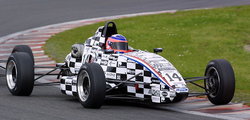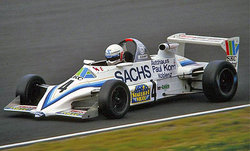Formula Ford
Formula Ford is a single seater, open wheel class in motorsport which exists in some form in many countries around the world. It is an entry-level series to motor racing, in which in the past many drivers aspired to one day reach Formula One (today karting is more likely to be a young driver's entry to serious formula car racing).
History
When the formula was first established, it ran on road tyres, used road gearboxes, and a price cap was placed on rolling chassis - the intention was very much to create an affordable form of single-seater racing. John Webb of Brands Hatch, Geoff Clarke of Motor Racing Stables (the circuit's resident race driving school) and Jim Russell were largely responsible for its creation. The first Formula Ford car was Team Lotus' 1966 Type 31 which was derived from the Lotus 22 Formula Junior. Unlike its great rival as an entry level formula, Formula Vee, the Formula Ford cars use full racing suspension setups.
The Formula
Formula Ford racing exists in two main forms: National Series run around the world using the 1600 Duratec engine, (which replaced the heavier but not significantly more powerful Zetec engine in 2006); and a mainly amateur, club-racing series attracting serious enthusiasts using the now elderly 1600 Kent Engine with which the formula ran from mid-sixties to mid-nineties. The car can provide drivers with their first insights into how a racing car feels to drive and how to properly set up a car, or it can provide a relatively inexpensive way for drivers to campaign purpose-built racecars for many years. Many Formula Ford 1600 series exist for drivers of the older Kent powered cars.
A Formula Ford car is one of the more distinctive-looking open-wheel race cars because it does not have wings to create aerodynamic downforce, one of the reasons the series has persisted for so long in motor racing. Top speeds in the National Class are as high as in the other Junior Formulae of BMW and Renault, but the cornering speeds are lower due to the downforce-producing aerodynamic aids on the other cars. Handling is entirely down to mechanical grip, and the lack of wings ensures that cars following another are not aerodynamically disadvantaged, allowing close racing with plenty of overtaking. Series' rules may permit slick tires or treaded tires. As the rules limit modifications, all cars are relatively equal and produce close racing results. Still, Formula Fords allow suspension and braking bias changes, if not aerodynamic options like winged cars.
Formula Ford cars weigh 410/420 kg (1000 lb), so their engines, which typically develop about 140/115 hp, are capable of propelling them from 0–100 km/h in less than five seconds, reaching top speeds of nearly 235/220 km/h (150/140 mph). The engine is usually a stressed member of the chassis, as in larger and more advanced Formula cars.
Several famous race drivers have used the formula as a step up to international competitions. For example, David Coulthard and Jenson Button were both British Formula Ford champions; Danica Patrick, the first female to win a major race in the IndyCar Series on a closed-course, finished second in the British Formula Ford Festival early in her career. In the late 1960s and early 1970s, Emerson Fittipaldi and Jody Scheckter were both competing in Grands Prix within a year or so of starting Formula Ford in Britain.
Many championships are run around the world for Formula Ford including Australia, New Zealand, Canada, Asia, and South Africa. Each run instrinsically the same rules and regulations with minor variations for local conditions.
Ford Championships around the world
- Asian Formula Ford Championships ([1])
- Australian Formula Ford Championship ([2])
- British Formula Ford Championship ([3])
- Canadian Formula Ford Challenge ([4])
- Dutch and Benelux Formula Ford Championships ([5])
- Finnish Formula Ford Championship ([6])
- New South Wales Formula Ford Championship ([7])
- North European Formula Ford Championship ([8])
- South African Formula Ford Championship ([9])
- Irish Formula ford
- MTA New Zealand Formula Ford Championship
- Pacific Formula Ford 2000 Championship ([10])
- F2000 Championship Series ([11])
The Chassis
In order to reduce cost, chassis are steel space-frame, unlike the monocoques found in other types of single seater racing. The more popular marques are currently Van Diemen, Mygale and the Australian built Spectrum, but smaller manufacturers such as Ray or Vector have had some success. In recent years, in the United States, Pipers have also been campaigned with strong results. Historical designers who have made a mark on the series have included: TitanTemplate:Dn, Lotus, Merlyn, Hawke, Citation, Swift, Euroswift, Elden, Reynard, Crosslé, Lola, Zink, Bowin, Royale, and Cooper Racing.
The Engine
Formula Ford racing cars can be fitted with different engines. After some very early races with the 1500 cc Ford Cortina GT engine, the formula rapidly adopted the OHV 1600 cc Ford Kent engine, using production blocks with little special preparation. In 1994, Ford replaced its Kent block engine with the more modern and more powerful 1800 cc 16-valve Zetec. The advent of the Zetec created a new class of Formula Ford cars popular in some countries, although the increased weight of the engine was felt to adversely affect the handling of the cars. The formula originally mandated production gearboxes, wheels and tyres (and a maximum cost for the rolling chassis, although this was long since abandoned), but Formula Fords now use racing gearboxes and, in some championships, slick tyres.
For the 2006 season, the Zetec engine is being superseded by the 1600 cc, DOHC 16v Duratec engine. The Zetec was criticized by engineers and designers as less than ideal because of its bulk and weight. The move to Duratecs has brought Formula Ford back to using 1.6 L capacity motors. Despite the capacity decrease, the new engines are more powerful than the Zetecs, and weigh more than 20 kg less, reducing overall weight and increasing performance significantly.
Unusually for any racing formula, one Minister Racing Engines-built engine became a legend - known as "Patch" after the number of times its cylinder block had been repaired, the same unit won several Formula Ford festivals in different hands.
Administration
Ford administers some of the national Formula Ford championships around the world, but older cars are very popular with club racers, providing the ground for several organizations to run their own series. Many racing schools offer driver training in Formula Ford cars. However, in many countries, Formula BMW and Formula Renault Campus had superseded Formula Ford as the main entry level class, however 2006/7 have seen the Ford grids outdoing the BMW's and Renault's. In the UK there are many less important regional series aimed at the amateur enthusiast, as well as championships for older Fords.
For many years the highlight of the Formula Ford season was the Formula Ford Festival at Brands Hatch. Entries of several hundred cars from all over the Formula Ford world were common into the 1990s, with racers competing in knockout heats to decide the grid for a grand final. Entries have been declining and recent Festivals have struggled to attract more than 40-50 cars, enough for two heats and a final dash; more "historic" FF1600 cars have been turning up for the supporting races than contemporary Zetecs, however in 2006 the Festival saw the Duratec engine for the first time thereby having a final for all 3 marques at one meeting for the first time. The Walter Hayes Trophy now recognises the continuing interest in 1600cc 'Kent' Formula Ford and attracted over 150 entries in 2006, including several drivers more commonly seen in much more senior formulae.
Related Formulae
Formula Ford has given birth to several other categories of racing: Formula Ford 2000 evolved in the 1970s to use a Pinto engine and, although it used basically Formula Ford chassis, permitted use of slicks and wings; it was seen as a natural step up from the 1600cc formula and a stepping stone to categories such as Formula Three. Formula Ford 2000 engines and transmissions were married to sports-racing chassis to produce Sports 2000.
Older Formula Fords, with outboard shock absorbers, race in the United States as Club Formula Fords in SCCA and other club racing series.
Formula 100 was an unsuccessful attempt in the late 1960s to create a sportscar category related to Formula Ford but using a 1300 cc Ford engine; despite being extremely pretty, the cars were heavy and slow. The proposed Formula Turbo Ford (an attempt to update FF2000) of the mid-1980s was limited to one Reynard that ran a few demonstration laps.
Formula Ford remains immensely popular at grassroots level in its 1600 cc form, though — the cars are widely raced, sprinted and hillclimbed. Formula Continental is also a popular choice in the USA and Canada. The class provides a venue for Formula Ford 2000 as well as the earlier Formula C (1100 cc pure racing engine) and Formula Super Vee (production-based VW engines) cars. Formula Continental cars employ aerodynamic effects (front and rear wings).
However, the inherent danger of motorsport shows have been underscored by a number of devastating crashes, most famously, the crash of 19-year-old driver Lucas Dumbrell at the Oran Park Raceway in 2008. The incident occurred on the second lap of a 12-lap Formula Ford race which preceded the V8 Supercar championship race. Just seconds before the accident occurred the safety car had been deployed, causing the pack leaders to slow down as they rounded a dog-leg. Unfortunately, cars in the back half of the track were yet unaware of the yellow flag being raised and had not slow down, resulting in Dumbrell running over the back of a competitor and rolling his car. Dumbrell suffered severe spinal injuries that left him a quadriplegic. There have been many more less publicized but much more horrific crashes, such as Matthew Deitz's career ending crash at Brands Hatch in 1997.
Formula First was a partly successful attempt to get back to the roots of Formula Ford, with a spec FFord-like car running a transversely-mounted Ford engine in a very low state of tune; it was designed as an introductory formula and racing school chassis, and served in this capacity for some years.

